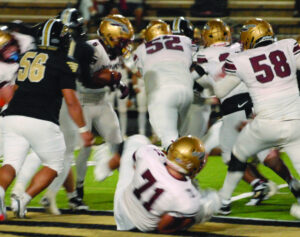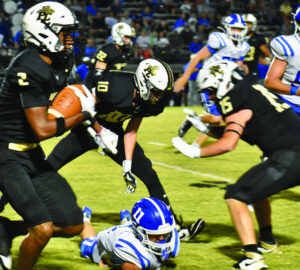You're either a chitlin lover or a chitlin hater
By By Robert St. John / food columnist
Feb. 26, 2003
Robert St. John is the executive chef/owner of New South Restaurant Group whose Web site is www.nsrg.com. His weekly food column appears in newspapers throughout Mississippi and Louisiana. If you have any questions or comments, he can be reached at robert@nsrg.com or (601) 264-0672.
Recently, I wrote a semi-controversial column about eating possum. I was unexpectedly bombarded with phone calls and e-mails from proud and angry possum eaters.
I had never eaten possum. I still haven't eaten possum. I began to worry that there might be other controversial Southern delicacies that I have been missing out on.
I have never eaten chitlins, either. Chitlins are a very divisive food. You are either a chitlin lover or a chitlin hater. Actually, you are "on the fence" until you eat your first bite and then you quickly hop on one side or the other.
I have always wondered about all of the fuss. Being the acutely intuitive investigative food journalist that I am, I decided to delve further.
I hesitated to write about chitlins this soon after the possum incident for fear that some readers might think this column is moving in a different direction and that my eating habits have headed down into the deep, dark, endless depths of the culinary root cellar.
Some might say I was already in the cellar and this in-depth treatise on the glory and wonder of the almighty chitlin would be an improvement.
The official name for chitlins is "chitterlings," but I won't use that. It's silly. It's sort of like spelling "possum" with the formal "opossum." Nobody does it, and I won't start here.
Chitlins are pig intestines. And we all know what runs through intestines. Needless to say, chitlins must be thoroughly cleaned. My friend, Banks Norman, eats chitlins.
He has tried to talk me into eating them. Last week, he told me how they were cleaned: he slings them against a tree stump, runs a hose through them, picks off the fat, boils them for four hours. He drains and changes the water three times during the boiling process, while skimming and picking more fat.
Four hours? Slinging intestines against a stump? Having to drain a boiled ingredient three times before you even get to the frying stage? Chitlins must be very tasty to go to all of that trouble.
Banks is a kidder. He keeps a few spare kernels of corn in his shirt pocket while eating chitlins. When no one is looking, he will slip the kernels into his mouth and wait for the perfect moment during the meal to spit them out into his hand. "Hey! Who cleaned these chitlins?"
Never having eaten pig intestines, I imagined they would have the consistency of crispy-fried calamari with the flavor of smoked bacon a slight-rubbery texture with a nice hint of piquant pork surrounded by a crispy-fried breading of seasoned French bread crumbs. Sounds good to me.
I have eaten bacon-wrapped diver scallops, oysters en brochette, shrimp wrapped in bacon and broiled oysters stuffed with a bacon dressing. The seafood-pork pairing is well-known. Maybe chitlins and this imagined calamari/pork combination would taste like those familiar dishes. Andouille sausage is made from chitlins and tripe. I love Andouille sausage.
One of my favorite catfish houses is Rayner's Seafood House. The Rayners have been frying fish in the same location on US 49, north of Hattiesburg, since 1961.
Rayner's is home to some of the best fried catfish in Mississippi. They serve fried green tomatoes, fried dill pickles, excellent Cole slaw and some of the best hushpuppies you will find.
While eating catfish at Rayner's, I noticed a sign that read: "Chitlins Tuesday Only. Fried or boiled All you can eat $12.95. Half &Half All you can eat $14.95 . Dasani Water $1"
At first I wondered if anyone ever took full advantage of the all-you-can-eat promise. I can't imagine anyone consuming more than one plate of chitlins.
I also wondered what bottled water had to do with eating chitlins. Those two foodstuffs seem diametrically opposed.
As an uneducated chitlin eater, I wondered if bottled water was required to eat chitlins. I began to worry. Does bottled water make them cleaner? Does bottled water make them taste better? Does it have something to do with the cleaning process that I don't know about?
Is there something in chlorinated-tap water that interacts with pig intestines and makes you grow hairy ears, a snout and tusks? Note to self: When eating chitlins, order bottled water. And why is the combo platter, fried and boiled, $2 more? I decided to return to Rayner's on the following Tuesday and boldly go where no St. John has gone before into the culinary root cellar that is the underbelly of the pig chitlins!
Next week: Chitlins Part II: Robert Takes a Bite
Creole Cheese Fritters
3/4 cup Parmesan cheese, grated
3 eggs
1/4 cup parsley, chopped fine
1/4 cup green onions, medium dice
1/4 cup horseradish
1/4 cup sour cream
11/2 tablespoon garlic, minced
1 tablespoon creole seasoning
1/4 teaspoon red pepper, crushed
1 cup flour
1/2 tablespoon hot sauce
10 ounce pepper jack cheese, grated
6 ounce mozzarella cheese, grated
6 ounce cheddar cheese, grated
Place Parmesan cheese, eggs, parsley, onions, horseradish, sour cream, garlic, creole seasoning, red pepper, flour, and hot sauce in an electric mixer and combine at medium speed. Add the three cheeses and continue mixing until well blended. Do not over mix.
Heat cottonseed oil to 350 degrees in a cast iron skillet. Drop golf ball-size spoonfuls of cheese fritter mixture into hot oil, making sure not to cook too many at once.
Serve with comeback sauce for dipping. Yield: 24n30.








